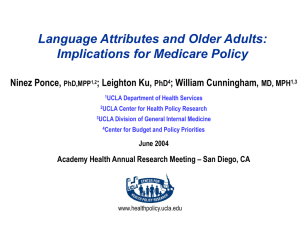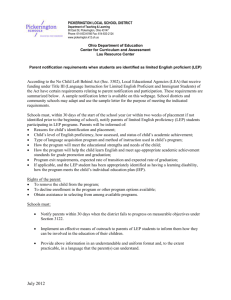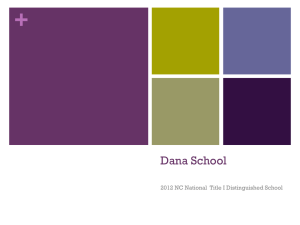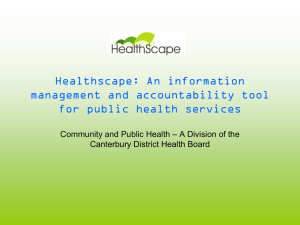Language Attributes and Older Adults: Implications for Medicare Policy Ninez Ponce,
advertisement
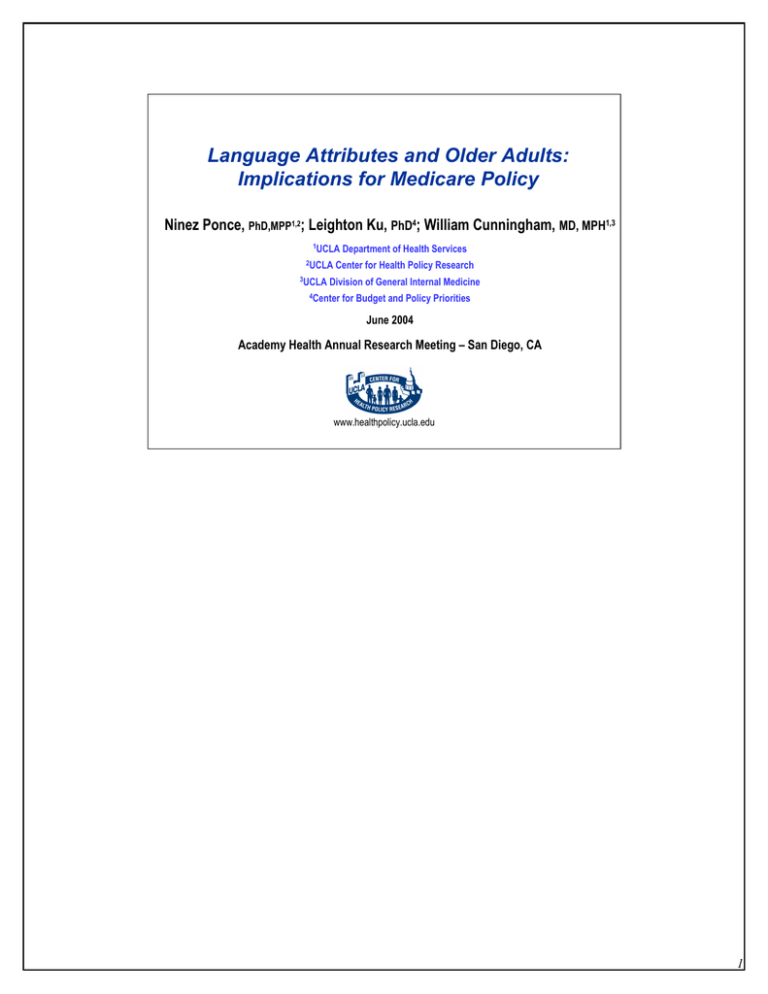
Language Attributes and Older Adults: Implications for Medicare Policy Ninez Ponce, PhD,MPP1,2; Leighton Ku, PhD4; William Cunningham, MD, MPH1,3 1UCLA 2UCLA 3UCLA Department of Health Services Center for Health Policy Research Division of General Internal Medicine 4Center for Budget and Policy Priorities June 2004 Academy Health Annual Research Meeting – San Diego, CA www.healthpolicy.ucla.edu 1 Background Å 2000 Census reveal that a large number of seniors — about 2.3 million or almost 7 percent of persons 65 or older — do not speak English Å Immigrants to the U.S. are likely to face numerous challenges – including language barriers – that affect their health status and care Å Most research concerning health disparities related to limited English proficiency (LEP) or immigration status have focused on low-income children and families and, therefore, on Medicaid policies Å This study investigates whether such disparities also occur among older adults—a majority who are covered by Medicare 2 2 Research Objective Å We investigate if and to what extent there are disparate patterns by language attributes in self-reported general and emotional health, having a usual source of care, seeing a doctor over the past year, and experiencing delays in obtaining care among older adults Å We focus on California—a state that leads the nation as the home to nearly 40% who speak a language other than English at home (Census 2000) 3 Understanding the correlates of obesity and physical inactivity among a diverse population of Latino adults will aid in developing targeted interventions to reduce obesity, increase physical activity, and reduce risk for diabetes 3 Funders National Institute for Aging; P.I. Carol Mangione; Pilot Grant to N. Ponce; Mentor W.Cunningham P.I. Leighton Ku; Co-PIs ER Brown, N.Ponce 4 4 Study Design Å Data Source 2001 California Health Interview Survey (CHIS 2001) ¾ Random-digit dial (RDD) telephone survey, providing a representative sample of the state’s non-institutionalized population ¾ Conducted in English, Spanish, Mandarin, Cantonese, Vietnamese, Korean and Khmer Å Sample 10,994 adults age 65 and over Å Analyses Descriptive analyses of health status and access to care measures by language attributes Logistic regression models weighted to the 2000 Census to examine the association of language attributes to several health status and health access measures 5 5 Dependent Variables Å Health Status Self-reported general health “In general, would you say your health is excellent, very good, good, fair, or poor?” Self-reported emotional health “Did you feel downhearted and sad (all of the time, most of the time, some of the time, a little of the time or not at all)?” 6 6 Dependent Variables Å Health Care Access Having at least one doctor visit in the past 12 months “During the past 12 months, how many times have you seen a medical doctor?” Having a usual source of care “Is there a place that you usually go to when you are sick or need advice about your health?” Delaying medical care “During the past 12 months, did you delay or not get any other medical care you felt you needed—such as seeing a doctor, a specialist or other health professional?” 7 7 Regression Analyses: Independent Variables Å Main Independent Variable: Language Ability ¾ LEP – individual speaks English “not well or not at all” ¾ Bilingual – individual speaks a language other than English at home but reported speaking English “well or very well”. ¾ English only – individual speaks only English Å Other Independent Variables: Socioeconomic/Demographic - Race/Ethnicity, Years lived in the U.S., Health insurance status, Gender, Cohabitation structure, Age, Area of residence, Education, Household Income (as % of FPL), Health Status - Number of chronic conditions 8 8 Sample Characteristics, Adults Age 65+ Race/Ethnicity LEP (n=551) Bilingual English only (n=1285) (n=9154) Total (n=10,994) Latino 41.3 22.0 1.2 6.5 Asian 46.0 22.8 2.6 7.9 Black 0.1 2.1 6.5 5.9 American Indian/Alaska Native 0.0 0.3 0.4 0.3 Other single race/multiracial 2.8 7.3 1.9 2.3 White 9.7 45.5 87.3 77.1 Source: 2001 California Health Interview Survey 9 9 Sample Characteristics, Adults Age 65+, Cont’d Insurance Status LEP (n=551) Bilingual English only (n=1285) (n=9154) Total (n=10,994) Uninsured 4.1 0.2 0.2 0.6 Private only 8.9 4.6 4.0 4.6 Medicare only 8.9 10.2 5.7 6.7 Medicare plus Medicaid 58.9 22.8 14.4 20.1 Medicare plus private 19.1 62.2 75.7 68.0 Source: 2001 California Health Interview Survey 10 The sample was predominately female, between the ages of 65 and 74, urban dwelling, lived with others, with at least one chronic condition Substantial numbers of LEP (n=551) and bilingual speakers (n=1285) LEP speakers had fewer HS grads, greater proportions in poverty and more noncitizens than bilingual and English only speakers Adequate representation of Latinos (n=560) and Asians (n=489) However, population proportions, are less than 15% of the total age 65+ population compared to 32% (Latino) and 11% (Asian) of California’s overall population Very few elderly lived in the U.S. less than ten years (n=45) 10 Unadjusted Rates, Adults Age 65+ Sample Size Unadjusted Rates (%)† Dependent Variable LEP/Bilingual/English Only LEP Bilingual English Only All Elderly Health Status Reported fair or poor health status1,2 327 / 340 / 2441 60.2 26.5 26.3 28.7 57 / 54 / 305 10.5 4.5 3.2 3.9 505 / 1204 / 8628 92.3 93.5 94.6 94.2 510 / 1242 / 8891 94.1 96.6 97.5 97.1 29 / 69 / 487 7.3 4.7 5.1 5.3 Felt sad all or most of the time1,2,3 Health Access Saw a doctor in the past 12 months1 Have a usual source of care1,2 Delayed care1,2 † Weighted to Census 2000 estimates of California’s 65 and older population. We performed two-sample tests of proportions comparing unadjusted rates. Comparisons at p ≤ 0.05 are designated as: (1) LEP ≠ English only, (2) LEP ≠ Bilingual, (3) Bilingual ≠ English only Source: 2001 California Health Interview Survey 11 11 Summary of Bivariate Analysis Å Compared to those who speak English only, LEP individuals had: Higher % in poorer general and emotional health and who had delayed care Lower % who had an annual doctor visit and who had a usual source of care Å Compared to those who were bilingual, LEP individuals had: Higher % with poorer health status and access Equivalent % who had at least one doctor visit Å Compared to English only speakers, bilingual speakers had: Similar % with poorer health status and less access to care Higher % in poorer emotional health 12 12 Adjusted Relative Risks, Adults Age 65+ LEP vs. English Only† Baseline Rate (%) Adjusted Relative Risk†† Reported fair or poor health status 15.6 Felt sad all or most of the time Dependent Variable Bilingual vs. English Only† 95% CI Baseline Rate (%) Adjusted Relative Risk†† 95% CI 1.89 1.44, 2.43* 18.9 0.93 0.78, 1.10 3.6 2.41 1.36, 4.14* 3.9 1.50 1.07, 2.08* 86.0 0.96 0.83, 1.06 85.4 1.00 0.93, 1.04 Health Status Health Access Saw a doctor in the past 12 months Have a usual source of care 90.3 0.81 0.60, 0.96* 89.2 0.97 0.90, 1.02 Delayed care 15.1 1.98 1.25, 2.90* 14.4 1.20 0.88, 1.61 * p ≤ 0.05; † Weighted to Census 2000 estimates of California’s 65 and older population; ††Adjusted for race/ethnicity, insurance status, gender, living arrangement, family income as % FPL, length of residency in the U.S., education, age, urban vs. rural, and number of chronic conditions. 13 Source: 2001 California Health Interview Survey 13 Summary of Multivariate Analysis – Health Status Å Fair/Poor Health Status RR for LEP seniors was nearly twice that of English only speakers Å Emotional Health, feeling sad all or most of the time RR for LEP seniors was more than twice that of English only speakers Higher RR for bilingual speakers than for English only speakers Å Usual Source of Care LEP individuals were less likely to have a USOC than English only speakers Å Delays in Care LEP individuals were twice as likely to delay care as compared to English only speakers 14 14 Conclusions Among older adults, LEP individuals were more likely to report worse general and emotional health and worse access to care than English only speaking individuals. With the exception of our emotional health measure, bilingual speakers and English only speakers were very similar across all health status and access measures Compared to English only speaking individuals, the barriers to care are clearly faced by LEP individuals, but not by bilingual individuals who are English proficient However, bilingual older adults are at increased risk of reporting feeling sad all or most of the time as compared to English only speakers, although their increased risk is lower than LEP individuals 15 Study Limitations California may not be generalizable to the the rest of the U.S. The CHIS 2001 telephone administration systematically excluded households without telephones--which may more likely be lowerincome and/or LEP CHIS 2001 was conducted in Spanish and several Asian languages so monolingual speakers of other non-English languages may not have been represented in the survey 15 Policy Implications Å Policy discussions about increasing the availability of interpretation services has primarily focused on problems occurring among the Medicaid and the uninsured populations Å This paper demonstrates that language barriers should also be of concern to those who establish policies for Medicare Å In light of the demographic trends of growth in the immigrant and the older adult populations, these problems will become more common in the coming years Å Federal civil rights policies already establish the rights of LEP patients to interpretation services, but Medicare policy regarding the availability of and payment for language services ought to come into concordance 16 16
